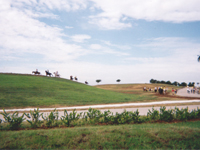Basic Information
EPA's National Revitalization Web Sites
Davie, Florida

The Davie Landfill Superfund site, a former municipal landfill, is now known as Vista View Park, which includes walking, bike, and horse trails; picnic shelters; and a catch-and-release fishing pond. For more information…(2 pp, 191 K, about PDF)
EPA and Region 4 seek to support the reuse and redevelopment of all types of contaminated properties, including brownfield sites, Superfund sites, RCRA sites, UST sites, and more. Land revitalization is important because it returns land to productive use, restores blighted properties, can be linked to local job opportunities, creates recreational opportunities, energizes neighborhoods, and protects the environment.
The land revitalization activities in Region 4 help to ensure that reuse considerations are integrated into all cleanup decisions. Contaminated and formerly contaminated sites throughout the country have been transformed into major shopping centers, business parks, residential subdivisions, recreational facilities, and wildlife habitat. Many sites are being revitalized for use by small businesses.
- Why is revitalizing contaminated property and formerly contaminated
property a good idea?
Many contaminated sites and properties have advantageous locations - accessible to infrastructure and close to people – that make them good candidates for revitalization projects. EPA has many revitalization tools (informational, financial, legal, technical) to assist you in redeveloping your site or property. Additionally, some federal, state and local government agencies offer grants, loans, and other incentives to encourage development of contaminated and formerly contaminated properties, and their surrounding areas. Many sites are already very well characterized, which minimizes future surprises regarding unknown or undiscovered contamination issues. - Getting started: How can I begin revitalizing a site or property?
The effective revitalization of a contaminated site or property normally requires a number of important steps, and there is no single “revitalization formula” that applies across the different types of sites. For example, brownfield sites and Superfund sites have very different steps for a successful revitalization. The good news is that there are site-specific steps to undertake that will allow you to take advantage of appropriate revitalization tools and resources to redevelop a particular type of site. EPA and relevant state environmental agencies have developed tools and resources that can help you in redeveloping your site or property.
![[logo] US EPA](../gif/logo_epaseal.gif)